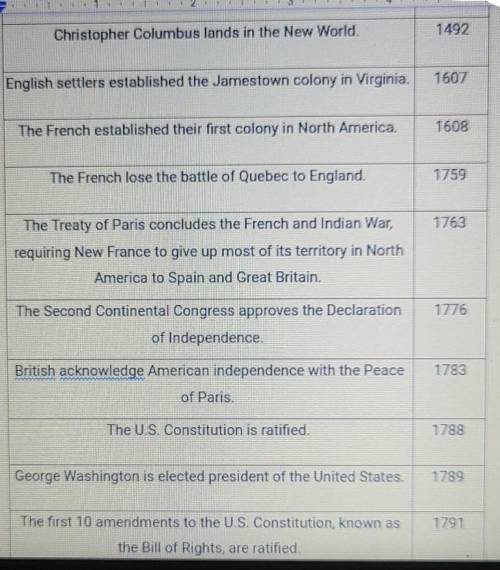
History, 14.10.2021 07:10 teFazoe9550
As you put these events in chronological order, did you notice any themes or trends? Chronological thinking, specifically the act of putting past events in order, helps historians make sense of the past and create historical narratives. Simply put, historical narratives are stories of the past.
With this in mind, write a brief historical narrative of early American history using these events and your general knowledge of the past. Your narrative should be one or two paragraphs long and include at least 6 of the events listed above.


Answers: 2


Other questions on the subject: History

History, 22.06.2019 08:30, mathman783
How did the love and black elite gain financial security during the antebellum period
Answers: 1

History, 22.06.2019 09:00, lkarroum3733
Which is textual evidence offering an intimation that george can be caring and thoughtful?
Answers: 3

History, 22.06.2019 13:00, oroman4650
To build and maintain civil society, young citizens must be taught the skills involved in activities related to civic engagement. schools address this need with courses like the one you are taking or in civics courses. civil society organizations also provide training activities and other ways of welcoming young people, new citizens, or simply new members into this sphere of activity. other mechanisms exist for ongoing civics training, including video games! watch this brief discussion of how video games and the online world hold the ability to provide safe places for people of all ages to build skills for civil society and perhaps even apply them to their real-world concerns. write one to two paragraphs that reflect on the arguments made in the video about building skills for civil society and civic engagement. you may include an example where you have participated in such an event through a video gaming experience.
Answers: 2

History, 22.06.2019 15:00, dsanders20
“in december 598 [b. c.] nebuchadnezzar left babylon once more to campaign in the west. he besieged jerusalem, which had rebelled three years earlier, and on 16 march 597 it fell. king jehoiachin and many of his subjects were deported to babylon and zedekiah was installed as king of judah in his place. after some years zedekiah too rebelled. the babylonians began a siege of jerusalem which lasted for more than a year. the walls were finally breached in the summer of 587 . . and the city surrendered about a month later. much of jerusalem may have been destroyed at this time and more jews were deported.” —michael roaf, cultural atlas of mesopotamia and the ancient near east what can you conclude about the jews from this passage? a. they admired nebuchadnezzar. b. they did not try to defend their city. c. they were stronger than the babylonians. d. they wanted to be independent. select the best answer from the choices provided a b c d mark this and return
Answers: 2
You know the right answer?
As you put these events in chronological order, did you notice any themes or trends? Chronological t...
Questions in other subjects:


History, 24.11.2019 00:31



Mathematics, 24.11.2019 00:31

Chemistry, 24.11.2019 00:31

Chemistry, 24.11.2019 00:31

Mathematics, 24.11.2019 00:31

Biology, 24.11.2019 00:31



